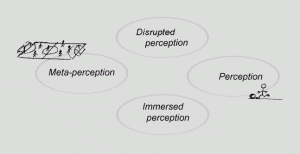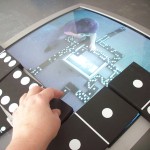A number of TV-games that I tried out before hitting on the Double Solo game.…
You buy it, but it owns you
 As today is graduation day I’m ruminating on what all happened these last 12 months. Had a look through the pics that I have uploaded to this blog, the one you see here being the very first one. Funny to see that even then I had ‘play’ on my mind, even though the idea was more a rough diamond than a cut stone.
As today is graduation day I’m ruminating on what all happened these last 12 months. Had a look through the pics that I have uploaded to this blog, the one you see here being the very first one. Funny to see that even then I had ‘play’ on my mind, even though the idea was more a rough diamond than a cut stone.
I did make a lot of miles this last year. And to stay with the diamonds analogy: it was a question of grinding and polishing. Being part of such a talented – and ego-driven – group was challenging. The first few months I spent just keeping my head above water. Keeping a diary-style weblog was very important to me at this near-drowning stage. Then I caught on, both on the theoretical side and on the practical side. One of the things Klaas said to me in december was crucial: “Art research can speculate“. As I have an engeneering background, speculation hadn’t been part of my professional makeup, really. Once I got this ‘speculation’ thing into my system, I never looked back.
My first speculations were about the way perception works in gaming. I’ve been writing about it in my essay and I’m copying it here:
Perception, immersed perception, meta-perception
Gamic Vision
Wittgenstein drew a simple scheme depicting an eye and its field of vision. And then said: “our vision does not look like this’. Thus, he concluded, the person that perceives the world does not belong to the world, but is its boundary. (1)

” We are eternally making over the world in our minds, and much of it is fantasy.” (2)
“There was a great Nintendo commercial a few years back in which a kid on vacation with his Game Boy starts seeing everything as Tetris blocks. Mount Rushmore, the Rockies, the Grand Canyon – they all morph into rows of squares, just waiting to drop, rotate, and slide into place. The effect is eerie, but familiar to anyone who’s ever played the game. The commercial captures the most remarkable quality of video and computer games: the way they seem to restructure perception, so that even after you’ve stopped playing, you continue to look at the world a little differently. “(3)
It is difficult to perceive perception – we are bound by and to our position in time and space. To position ourselves, we have to do something that is by its nature contrary: we must both see ourselves in the here and now and abstract ourselves from it. Abstraction in time is handled by the narrative of identity: the story of who we are, where we came from and where we think to go. Abstraction in space is handled by the mental map we construct, depicting our surroundings and placing ourselves on it so as to position ourselves in respect to other people, objects and landscapes.
Games, when analyzed for their perceptual requirements, turn out to be even more complex situations. When playing a game, and playing it well, one alternates between – or performs simultaneously – at least three different modes of perception.
The first mode is that of individual perception: who am I, where am I situated, what does my environment look like, and what actions am I asked to or able to perform? Games act as ready-mades in this respect, as models for action that enable us to situate ourselves at a glance and establish immediate relations with other players. They also enable us to draw upon a store of acts and decisions learned when playing games before. This may be as simple as the series of rules that enable us to recognize a game of hide and seek and to play this particular game, or as complex as our understanding of the game of chess and our store of knowledge about chess variations and moves.
This store of knowledge enhances our pleasure in the game and provides a framework that frees us to focus intently on the play experience itself. The predictability of games make them ideally suited for the trance-like playing that is the hallmark of the second mode of perception: immersed perception. When immersed in a game, players’ perception, their reactions and interactions all take place within the framework of the game. This is the state in which we can only play when not knowing the rules any more, forgetting everything we were ever taught.
Then there is a third mode of perception. Full participation in a game requires immersion, while at the same time it enhances individual perception to a point where perception cannot be fully anticipated or controlled by the individual. Gadamer asserts the primacy of the play over individual consciousness: “The players are merely the way the play comes into being.” The game thus becomes self-moving, requiring us to play along with what we bring into being. It takes us out of ourselves and makes us part of a larger whole. Perception of this larger whole I will call meta-perception: the point where the individual becomes part of a larger system, and this larger system becomes part of the individual. “This is the moment you are ‘ín form’ in both senses. It feels good and there is this whole hectic feeling of extension into the world that is being ‘informed’.“ (4)

Online games offer fascinating examples of perception and meta-perception in play. Perception is usually represented by the POV or Point-Of-View shot, also called the FPP or First Person Shooter. Meta-perception is represented by the HUD or Heads-Up-Display. These two layers, and the interplay between them, are the conventional format for online shooter games like Call of Duty.
In the virtual world of the game these two layers supplement and enable each other. The POV represents the full volume of the world, extending in three dimensions, varied, spatial, and textured. The HUD exists in a flat plane and is overlayed on top of the first layer. The HUD meta-perception layer benefits from the richness, dynamic motion and narrative illusion of the POV, adding a more static, informatic permanence, offering information or giving various updates to the operator. In contrast, the first layer benefits from the spatial overview, structuredness and abstracted spatial relations of the HUD. Interplaying these two levels mimicks the way ‘real’ space is represented in the human mind, and so enables players to experience the virtual reality of the game as a traversible space.
The most interesting terrain, of course, lies inbetween: immersed perception. The pleasure of playing a game lies in entering this mental state: in responding automatically, processing information effortlessly, become an instantaneous decision making unit, walking on a path chosen without self-conscious thought.
Interrupting this flow is the aim of my game modifications. It’s rather like throwing a stone into a pond to create waves on a smooth surface: disrupted perception. It is important to me to create disruption, to introduce an element of doubt about one’s worldview. I hope to make people see – again – that perception is just that: perception: “you buy it, but it owns you”. (5)
(1) Ludwig Wittgenstein, Tractatus Logico-Philosophicus’ section 5.6331
(2) Brian Sutton-Smith, the ambiguity of play, page 156
(3) Ted Friedman,Civilization and Its Discontents: Simulation, Subjectivity, and Space http://www.duke.edu/~tlove/civ.htm
(4) David Winner, Brilliant Orange, page 71.
(5) http://wwwtomevansorguk.blogspot.com/2010_06_01_archive.html
| « Grownups around | <-- previous post | next post --> | Graduation » |
|---|







